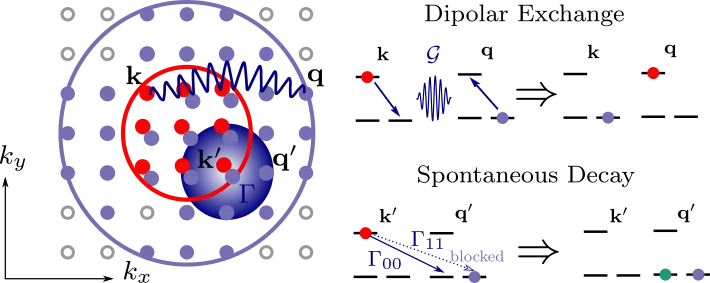In Plain English

Spontaneous emission of light is one of the most ubiquitous and fundamental processes in nature. It is what makes fireflies glow, but perhaps surprisingly is fundamentally a quantum process.
In the quantum description an excited atom decays to a lower energy state via emission of light in the form of a photon. This spontaneous emission is caused by the interaction between the light field and matter like atoms. Therefore, it depends both on the properties of light as well as matter. This in turn allows us to engineer the emission properties by designing these properties
One interesting avenue in this respect is to exploit the quantum nature of matter itself. In particular, there are (mainly) two types of quantum particles Fermions and Bosons. Two Fermions cannot be in the same state. As a consequence a fermionic atom can become infinitely lived if the emission process would put it into a quantum state already occupied by another atom.
This work explores this effect, the Pauli blocking of emission of light, in a two-dimensional gas of fermionic atoms close to quantum degeneracy. It develops a theory framework to describe the dynamics which provides the interpretation for experimental results observing for the first time enhanced life-times directly in the atomic sector.
The experiment proceeds by first exciting the atomic gas by an initial laser pulse in a preparation step. Consequently, the number of remaining excited atoms is observed directly and tracked over time. The exciting observation is that the atoms in this quantum degenerate 2D gas indeed live longer than they would in free space in absence of the other atoms.
Research

Spontaneous emission of light by optically excited atoms is one of the most fundamental processes in nature. At its heart is the interaction of light with matter.
This work studies the interplay of quantum statistics, in the form of Pauli blocking, and cooperative effects due to dipolar interactions induced by exchange of virtual photons, and atomic motion in a long-lived two-dimensional Fermi gas.
I develop a framework to describe the dynamics of an optically excited cloud of atoms confined in 2D, including both interaction effects, quantum statistics and atomic motion.
This is crucial for the description in the quantum degenerate regime and regimes of interest to experiment. It enabled the first observation of enhanced lifetimes due to Pauli blocking by direct observation of the atomic sector in a bulk system.